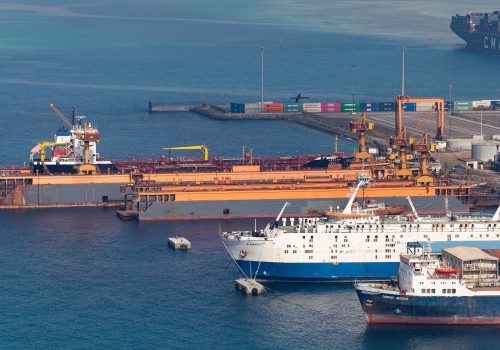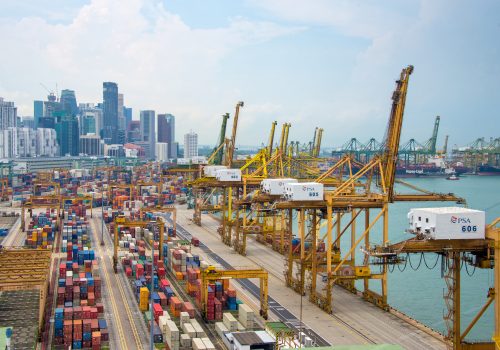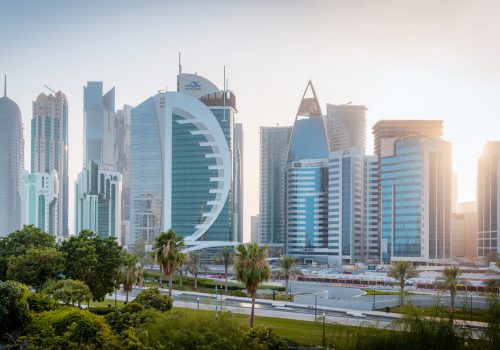The long shadow of the Red Sea shipping disruption
More than 80 percent of international trade by volume is transported by sea, and as the current situation in the Red Sea illustrates, disruptions to shipping routes can have wide-reaching effects.
The direct impacts of increased shipping time and fuel costs have captured the attention of market watchers and policymakers—but these are just the tip of the iceberg. As the disruption continues, firms will face challenges with increased insurance costs, decreased ship security, and wider ESG impacts, among others. The longer it lasts and the wider the area covered, the more numerous the challenges become.
The situation in the Red Sea also provides a small taste of the future of geopolitical risk. The Red Sea is one of the main trade routes between Asia, the Middle East, and Europe, with Clarksons estimating that 10 percent of world trade by volume utilizes this route. This includes 20 percent of all container shipping, nearly 10 percent of seaborne oil, and 8 percent of LNG. However, the Red Sea is not unique in its importance: Strategic chokepoints for maritime trade exist all around the globe, from canals to naturally occurring straits and funnels. As actors observe the impacts of Houthi threats and attacks, others will begin to consider their ability to orchestrate something similar. Of particular concern would be the potential for a global economic crisis if these methods were to be mimicked on other high-volume routes, in particular the South China Sea.
To prepare for and prevent these disruptions, policymakers need to understand the long shadow of disruptions to major shipping routes. And to do that it helps to explore the impact that the Red Sea disruption will have, depending on how long it lasts.
Effects of a disruption lasting one week to one month
Ship availability
In the medium term, one of the largest issues will be ships simply being in the wrong place. Supply chains have evolved to meet just-in-time strategies. This creates a delicate balance between each part of the supply chain, which is especially pressured between containers and ships.
Ports have limited berths, many of which are size specific, and limited physical space. Berths are booked months in advance to schedule appropriate port-side support for offloading, reloading, and refuelling. The ground delivery of containers and other goods are scheduled around these berth bookings.
As ships reroute or take alternative routes, the delays create a knock-on effect at the ports. When ships do not arrive at their berths on time, containers and goods fill the ports waiting for onward shipment. By rerouting or anchoring vessels, not only are supply chains slowed, but availability of transport options from ports is disrupted. Rerouted ships can overwhelm alternative ports, leading to back-ups at berths and clogged passage in/out of the ports.
As during the covid pandemic, containers quickly pile up in ports due to delays in ship arrival. This is exacerbated as vessels are repeatedly rerouted or ordered to anchor in an attempt to wait out the risk.
Insurance
Vessels “going dark”, when ships turn off transponders connected to tracking systems, has long posed a major risk. This is done to enable a wide range of illicit activities from evading sanctions to circumventing IMO rules or contractual limitations. The Red Sea has long been a hotspot for this activity due to its central positioning to countries bound by international trade sanctions. This is reflected in insurance premiums for vessels travelling through the area. Yet premiums will likely increase as the technique is utilised by ships to attempt to evade attacks from Houthi forces.
As ships go dark they become invisible to others in the area, both friend and foe. Ships are increasingly using this technique in the Red Sea as they anchor in place to avoid targeting. By masking their location, activity, and information from all parties they avoid detection by hostile forces, but also make the shipping lanes more dangerous. Transponders are utilised by other vessels to understand traffic, identify other ships in the area, and determine safe routes, particularly in crowded areas. An area such as the Red Sea filled with “dark” vessels would be equivalent to driving on a crowded highway in the dark without headlights. Without the information provided by trackers the risk of a major accident between large vessels increases substantially. That added risk will increase the cost of insurance.
Insurance costs will also be affected by the fact that the trip around the Cape of Good Hope is inherently riskier than Red Sea routes. Logistically, ships are required to not only navigate a longer route, but one battered by challenging weather patterns. Though ports across the Western coast of Africa are often better equipped to receive Capemax ships, this also enables possibilities for illicit activities based from and at ports. Geopolitically, vessels face increased danger from West African piracy, which is known for being particularly violent. This is further complicated by high levels of unrest across the area and limited state power should an incident occur.
Effects of disruptions lasting one to three months
Increase in shipping costs
Backlogs in ports, diversions, a decrease in ship availability, and the increase in insurance and other running costs will trigger pricing pressures. Shipping costs, which have already risen in the immediate term, will continue to rise. This is without considering the potential pricing impact if any vessel is significantly damaged during this period. Firms are likely to pass any price increase onto consumers to avoid substantial losses. This will hinder policymakers’ efforts to tame rising prices in an already high inflationary environment.
Carbon footprint
Shipping is already one of the most polluting industries in the world, contributing to nearly 3 percent of all global GHG emissions. “The sector, whose greenhouse gas emissions have risen 20 percent over the last decade, operates an ageing fleet that runs almost exclusively on fossil fuels,” according to the United Nations Conference on Trade and Development. But prolonged avoidance of the Red Sea will make that footprint worse.
The Cape of Good Hope route is not only considerably longer than the Red Sea-Suez Canal route—it also requires ships to burn significantly more fuel due to distance and the physical dynamics of the route. As more firms decide to send ships around the Cape, the carbon footprint of the industry is bound to increase.
For businesses, this comes as the EU rolls out their Emissions Trading System (ETS). As of January 1, maritime emissions are now included in the EU ETS for vessels calling at EU ports. The EU ETS levies a carbon tax based on the distance between the last port of call outside of the EU (excluding UK, Tangier and Port Said) and the first call into the EU. The charges are based on 50 percent of vessel emotions, half of the journey from a non-EU country into and out of the EU. As vessels increase the length of their routes and alternative ports become clogged, they will likely increase this distance and hence increase their tax liability. As the EU ETS system continues its rollout in the coming years, this added cost will only increase.
Effects of disruptions lasting three months or more
Increasing pressure to “friendshore”/onshore
Outsourcing and importing of goods have long been a focus of ire for politicians. An increase in shipping lead times and impact of foreign actors on the availability of critical items only exacerbates this. As the disruption in the Red Sea continues, the pressure for policies which encourage onshoring, and where not possible “friendshoring”, crucial trading goods will increase. In the next year sixty-four countries will hold elections, including the United States and the UK. A geopolitical environment which already turned domestic first following recent supply chain pressures will prove ripe for politicians looking to further onshore activities.
The future is green, or is it?
One of the biggest challenges facing the maritime industry is decarbonising the global fleet. Though many options are being explored, there is still no easy solution or currently fully viable and agreed upon solution or fuel alternative.
Firms are investing vast sums to test and explore the practicality of alternative fuel options. Requiring ships to reroute quickly, for whatever reason, has the potential to undermine these efforts.
The first hurdle of the transition is costs. The massive costs and challenges inherent in outfitting ships limits the ability of firms to investigate their viability. Building ships capable of operating on alternative fuels takes a significant amount of time and money. If the baseline costs of shipping increase, specifically insurance and fuel consumption of existing vessels in the fleet due to longer routes and time at anchor, the availability of capital will be squeezed further. The transition in shipping cannot happen without vast sums of money and any cut in profit will be felt first in R&D for future ships.
Alongside this, alternative fuels, such as LNG, LPG, methanol, biofuel, electric, and hydrogen, are currently distance and route limited. Though there are numerous initiatives being trialled across the globe, testing remains in the very early stages.
For some options, current technology means longer routes are just not feasible. This includes electric alternatives which are only used for short-distance routes at the moment. For others, such as hydrogen or LNG, the distance may not be a hindrance, but refuelling is. The port infrastructure to support alternative fuels is in its infancy and availability is spotty at best. This limits viable refuelling stops for vessels along every route. Redirection further limits these options until routes become impractical. Increasing the complexity of testing by changing pre-established routes, along which the refuelling prospects and sea conditions may be vastly different, can prohibit firms from further exploring alternative fuels.
Going forward the maritime industry needs to seriously consider how to finance the transition to greener fuels and ensure their availability, regardless of route. The current reality is far from this.
Long-term security of shipping routes
Current ship security is based on armed personnel and, in extreme cases, state-sponsored military support. These systems were based on a history of small-scale, sea-based operatives and independent actors posing the greatest threats to vessels.
Recent attacks in the Red Sea open a new frontier in shipping security risk. The Houthis have relied heavily on drones and ballistic missiles for their attacks. These are more complicated, difficult to counter, and at times, more precise than small-boat piracy, which has been accepted as “standard.”
On-board armed security is no longer enough, nor are smaller military vessels without the ability to tackle these threats. As this technology becomes more easily accessible, ensuring ship safety will be more costly and require more advanced technology.
The future of shipping risk
Despite recent efforts by Western powers to restore shipping in the Red Sea, the genie is now out of the bottle. The widespread redirecting of global trade has illustrated the power non-state and state actors can exert.
Even if a lasting ceasefire is agreed to immediately, ships cannot simply turn around and go back to their original routes. The substantial change in situational risk of the route will require a significant amount of contract renegotiation between shipowners and operators. Some owners may even restructure contracts to bar their vessels from being utilised on these routes. Nor will insurers and financiers be particularly willing to return to pre-ceasefire risk assessments. The Houthi attacks have opened the possibility of more sophisticated attacks through relatively accessible technology in busy shipping lanes.
There is a real risk that this model could be repeated by actors bordering other high-volume shipping routes. An area of similar, if not larger, risk would be a repeat of these actions in the South China Sea. It carries up to a third of all trade by volume and is a main energy transport route; any redirection there would have massive effects on global trade. Unlike the Red Sea, which acts as a funnel towards the Suez Canal, a high concentration of South China Sea routes require transport through the relatively narrow Strait of Malacca. Acting as a strategic chokepoint, this area is incredibly vulnerable. Though alternative routes exist, the physical limitations of these waterways make it a practical impossibility for the vast majority of ships. The combination of high volume and narrow passage means a disruption of this route of comparable scale could easily trigger a global economic crisis.
The coming weeks will determine whether we are facing a minor inconvenience or a larger challenge for international shipping. However, like the COVID-19 pandemic, this incident has underlined not only the importance of maritime trade routes but provided insight into the future of geopolitics. The ability to apply pressure to global trade structures is steadily becoming more accessible. States must adapt their international strategies to mirror the reality of the outsized impact certain actors, state and otherwise, can have on global trade.
Alex Mills is an international trade expert focused on services trade, international investment, maritime law, and ESG. They have nearly a decade of experience across the private and public sector, including in UK and US politics and the financial sector.

At the intersection of economics, finance, and foreign policy, the GeoEconomics Center is a translation hub with the goal of helping shape a better global economic future.
Further reading
Mon, Dec 18, 2023
What attacks in the Red Sea could mean for the global economy
Econographics By Hung Tran
Recent missile attacks on ships in the Red Sea by Iran-backed Houthi rebels have escalated regional tensions and disrupted global trade. Large shipping companies are now avoiding the route, causing significant costs and delays, which is impacting the the already fragile economy.
Tue, Apr 18, 2023
US trade agreements: Out with old and in the with new?
Econographics By
As the United States moves ahead with a new approach to trade with the Indo-Pacific Economic Framework for Prosperity (IPEF), should it really abandon the old model of trade agreements? Or should it consider adapting the new approach to the old model?
Mon, Jan 31, 2022
Strengthening ties: China and the GCC
Econographics By
As China continues expanding its trade ties across the world while the US focuses on its domestic economy, the US will find itself without a seat at the table when the norms for the multilateral trading system are set.
Image: Eilat, Israel September 26, 2022 The view of boats on the red Sea with the Jordanian mountains from Eilat Israel.


